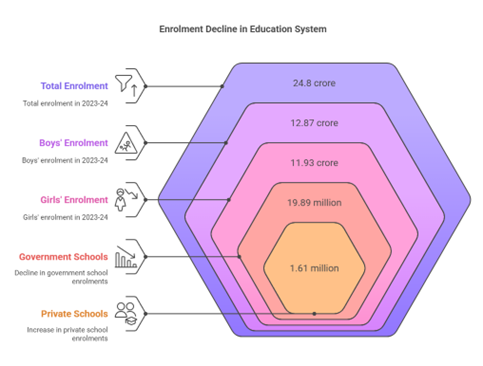THE CONTEXT: India is witnessing a worrying demographic transition, as highlighted by the UDISE+ data for 2023-24. It reports a significant 37 lakh (1.47%) drop in school enrolment compared to the previous year and a cumulative 15.5 million (6%) decline since 2018-19. This trend, driven by demographic shifts, declining fertility rates (2.01 in 2022), and socio-economic challenges, signals the potential premature end of India’s demographic dividend.
DEMOGRAPHIC DIVIDEND WINDOW AND CURRENT STATUS:
-
- Unemployment and Skill Gaps: Youth unemployment rose sharply from 5.7% in 2000 to 17.5% in recent years, with graduate unemployment as high as 29%. A mismatch between education and industry demands limits productivity gains.
- Shrinking Support Ratio: The support ratio (working-age individuals per dependent) is declining, from 14:1 in earlier decades to an estimated 4.6:1 by mid-century.
- Regional Disparities: States like Kerala and Tamil Nadu are ageing faster than others such as Uttar Pradesh and Bihar due to differential fertility rates.
- Education and Health Deficits: Infrastructure gaps persist; only about half of schools have functional computers and internet access. Poor health indicators hinder workforce productivity.
- Aging Population: By the mid-2050s, India will transition into an “aged” economy akin to developed nations, with seniors accounting for over 15% of consumption compared to just 8% today. Rising dependency ratios will strain public finances and social security systems.
KEY FINDINGS FROM U-DISE+ DATA (2023-24):
| CATEGORY |
FINDINGS |
DATA AND TRENDS |
| Decline in Enrolment |
Overall Trends |
– Total enrolment dropped to 24.8 crore in 2023-24, a decline of 1.22 crore (6%) from 2022-23. |
|
Gender-Wise Trends |
– Boys’ enrolment fell by 4.87%, from 13.53 crore (2018-19) to 12.87 crore (2023-24). |
|
|
Regional Variations |
– Bihar: Decline of 35.65 lakh students, from over 2.49 crore (2018-19) to over 2.13 crore (2023-24). |
|
| Government vs Private Schools |
Government Schools |
– Government schools saw a significant decline of 19.89 million (13.8%) in enrolments due to poor infrastructure and teaching quality. |
|
Private Unaided Schools |
– Private unaided schools registered a marginal increase of 1.61 million (2.03%), particularly at the senior secondary level, reflecting a shift toward private education among urban parents. |
|
|
Urban-Rural Disparity |
– In urban areas, 43.8% of primary school children attend private schools, compared to just 36.5% in government schools, driven by perceptions of better quality and English-medium instruction. |
|
| Demographic Shifts |
Declining School-Age Population |
– The school-going population (ages 6–17) declined by 17.30 million (5.78%) over the last decade due to falling fertility rates. |
|
Fertility Rate Trends |
– India’s fertility rate dropped to 2.01 in 2022, below the replacement level of 2.1, signalling a demographic transition toward an ageing society. |
|
| Infrastructure Gaps |
Basic Amenities |
– Over 90% of schools have basic facilities like electricity and gender-specific toilets. |
|
Digital Infrastructure |
– Only 57.2% of schools have functional computers, and just 53.9% have internet access, limiting digital learning opportunities. |
|
|
Accessibility Issues |
– Only 52.3% of schools are equipped with ramps, highlighting gaps in inclusivity for differently abled students. |

KEY INSIGHTS:
|
THE WAY FORWARD:
-
- Skill Development: Strengthen initiatives like Pradhan Mantri Kaushal Vikas Yojana (PMKVY 4.0)to provide NSQF-aligned training in Industry 4.0 skills such as AI, robotics, and machine learning. Establish the proposed five National Centers of Excellence for Skilling, focusing on industry-ready skills with global partnerships. Set up 50,000 Atal Tinkering Labs in rural schools to promote innovation and digital literacy.
- Female Workforce Participation: Introduce mandatory provisions for flexible work hours and remote working options in both public and private sectors. Expand creche facilities under the Maternity Benefit (Amendment) Act, 2017, especially for women in informal sectors. Scale up initiatives like Mahila Shakti Kendra to provide vocational training tailored to women’s needs.
- Education Reforms: Focus on foundational literacy and numeracy through the new 5+3+3+4 curricular structure. Introduce vocational training from Class 6 onwards with internships, as proposed under NEP. Provide broadband connectivity to all government schools by 2026 under the Digital India initiative.
- Healthcare Investments: Increase public healthcare spending from <2% of GDP to at least 3%, as the National Health Policy (2017) recommends. Strengthen Ayushman Bharat’s Health and Wellness Centers to improve access to primary care in rural areas. Promote preventive healthcare through awareness campaigns on nutrition and hygiene. The Lancet Commission emphasizes that investments in primary healthcare yield a return of $9 for every $1 spent.
- Job Creation: Promote labor-intensive sectors like textiles, construction, and MSMEs under initiatives such as “Make in India” and “Startup India.” Introduce tax incentives for industries that generate employment in underserved regions like Bihar and Uttar Pradesh. Foster green jobs by investing in renewable energy projects under the National Solar Mission. Bangladesh’s textile sector’s success demonstrates how targeted policies can drive job creation while empowering women.
- Social Security Systems: For informal sector workers, develop universal pension schemes like PM-SYM (Pradhan Mantri Shram Yogi Maandhan). Introduce long-term care insurance schemes for an ageing population similar to Japan’s Long-Term Care Insurance System. Strengthen schemes like PM-JAY (Ayushman Bharat) to cover secondary and tertiary care comprehensively.
THE CONCLUSION:
India’s declining school-age population and enrolment trends signal an urgent need for transformative policies that align education, skilling, and workforce planning with demographic realities. By leveraging technology, enhancing public-private partnerships, and prioritizing inclusivity, India can convert these challenges into opportunities to sustain its demographic dividend and ensure equitable socio-economic growth.
UPSC PAST YEAR QUESTION:
Q. National Education Policy 2020 is in conformity with the Sustainable Development Goal-4 (2030). It intends to restructure and reorient education system in India. Critically examine the statement. 2020
MAINS PRACTICE QUESTION:
Q. India’s declining school enrollment and shifting demographic trends pose significant challenges to its socio-economic development. Critically analyze the factors contributing to this decline and suggest measures to address these challenges.
SOURCE:
Spread the Word
